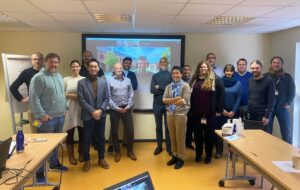Kickoff meeting held at ESRF for an additive manufacturing HUB
Laser-based processing of materials is highly valuable as it allows for innovative production routes. Here, printing of metals or metal powders into three-dimensional structures using rapid laser melting, so-called additive manufacturing (AM), has gained significant attention in recent years, i.e. from the academic community as well as industry. AM allows not only to perform rapid proto-typing but also to print or repair complex structures not accessible by traditional casting techniques.
Challenges remain in terms of quality control as printed structures made from metal can contain defects such as pores, a higher roughness and different strength properties: all widely related to significantly faster heating and cooling rates compared to traditional casting.
Large-scale facilities are beneficial to study properties of printed parts with high sensitivity and for in situ studies that give unique insight into how process parameters such as laser power or printing speed impact the properties of the final product. The related experiments are highly challenging as complex in situ environments are required, i.e. to print metals in an experimental environment while still replicating the process parameters relevant for real production processes. Currently, rigs have been developed for such experiments by individual groups but it takes a lot of effort, both for the group and for the facility, to host such experiments on a non-regular basis.

This meeting is a starting point to bring together the European community in AM to combine efforts while tackling a long-standing challenge in AM: sustainability.
As an example, aluminium powder can be made from recycled parts via AM, but the poor quality of the prints cannot yet compete with parts made from new materials; impurities, in particular, can impact the microstructure and hence the final quality of the product.
Participants of the additive manufacturing HUB meeting, ESRF 24/11/2022.
The new consortium targets this challenge by bringing together relevant players, from alloy development, simulations, building process replicators up to materials research. For that purpose, a hub proposal is now under preparation for early 2024, with the aim to seek regular access to beamlines for in situ studies performed by the consortium. In parallel, the consortium is submitting grant proposals to actively support the research onsite, namely the in situ rigs as well as the data processing routines required.
There were 22 participants in this two-day meeting held on 24-25/11/2022 at the ESRF, as a hybrid (in person and online) meeting. They included AM experts from German Aerospace Center DLR, University College London, IMDEA, University of Kassel, SIMAP, RMIT (Europe), Technische Universtiät Ilmenau, University of Manchester, Ecole Polytechnique Paris, and staff representing ESRF beamlines BM05, ID06, ID31, ID16A, ID16B and ID19 as well as the ILL SALSA instrument. The ESRF scientists hosting the meeting were: Alexander Rack, Yunhui Chen and Phil Cook.
The STREAMLINE project developed the concept of community access HUBs for ESRF users. STREAMLINE aims to encourage the formation of HUB such as this project of an additive manufacture HUB.